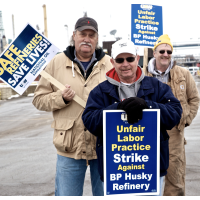Are Large-Scale Worker Strikes in U.S. a Thing of the Past?
 Oil refinery strikers, 2015
Oil refinery strikers, 2015
Big labor actions, once common in the United States, have become nearly non-existent, according to government data.
The Bureau of Labor Statistics reported that there were only 11 major work stoppages—involving more than 1,000 workers—in 2014, equaling the second lowest total since the bureau began recording such information in 1947. There were also 11 in in 2010 and only five in 2009. That compares to 470 such strikes in 1952.
In 2014, only 34,000 U.S. workers took part in work stoppages. The only year with fewer numbers was the recession year of 2009 when only 13,000 workers went on strike.
By 1980, the year Ronald Reagan was elected president, the number had fallen to 187—somewhat lower than the numbers from the 1950s through the ’190s, but still within that range. Then in 1981, the Professional Air Traffic Controllers Organization (PATCO) went out on strike. Reagan used that job action to fire the striking workers and even declare that they were no longer eligible to work for the federal government. Private industry took a cue from Reagan and began taking similar action against workers, knowing they would be backed up by the business-friendly Reagan administration.
In 1981 the number of large job actions fell to 145 and the following year it was down by a third to 96. The number never again approached triple figures. The year 1979 was the last in which more than a million American workers went on strike.
There was a blip in 2000 when about 85,000 Verizon workers walked off their jobs to protest mandatory overtime and jobs being moved to nonunion states. The strike was settled after 18 days with some concessions being made by Verizon limiting the amount of mandatory overtime that could be required, according to The New York Times.
The biggest strike in terms of worker-days lost in 2014 was 1,700 employees walking out of their jobs in October at FairPoint Communications. The strike was finally settled in February, with the unions agreeing to benefit cuts and a two-tier pay structure in exchange for a 1% pay raise. The 2014 strike with the largest number of participants was when nurses in California struck health-care provider Kaiser Permanente for two days to protest staffing levels. Earlier this year, about 7,000 oil refinery workers walked out to protest safety conditions at their facilities and for higher wages. A settlement was reached in March that was seen as favorable to the workers.
-Steve Straehley
To Learn More:
Major Work Stoppages in 2014 (Bureau of Labor Statistics)
Work Stoppages Involving 1,000 or More Workers Beginning in 2014 (Bureau of Labor Statistics)
Work Stoppages Involving 1,000 or More Workers, 1947-2014 (Bureau of Labor Statistics)
The 10 Biggest Strikes in American History (by Michael B. Sauter, Charles B. Stockdale, and Douglas A. McIntyre, Fox Business)
Verizon Strike Settled in Full After Accord On Overtime (by Simon Romero, New York Times)
Spreading Oil Worker Strike Biggest in U.S. in 35 Years (by Noel Brinkerhoff and Danny Biederman, AllGov)
- Top Stories
- Unusual News
- Where is the Money Going?
- Controversies
- U.S. and the World
- Appointments and Resignations
- Latest News
- Trump to Stop Deportations If…
- Trump Denounces World Series
- What If China Invaded the United States?
- Donald Trump Has a Mental Health Problem and It Has a Name
- Trump Goes on Renaming Frenzy






Comments